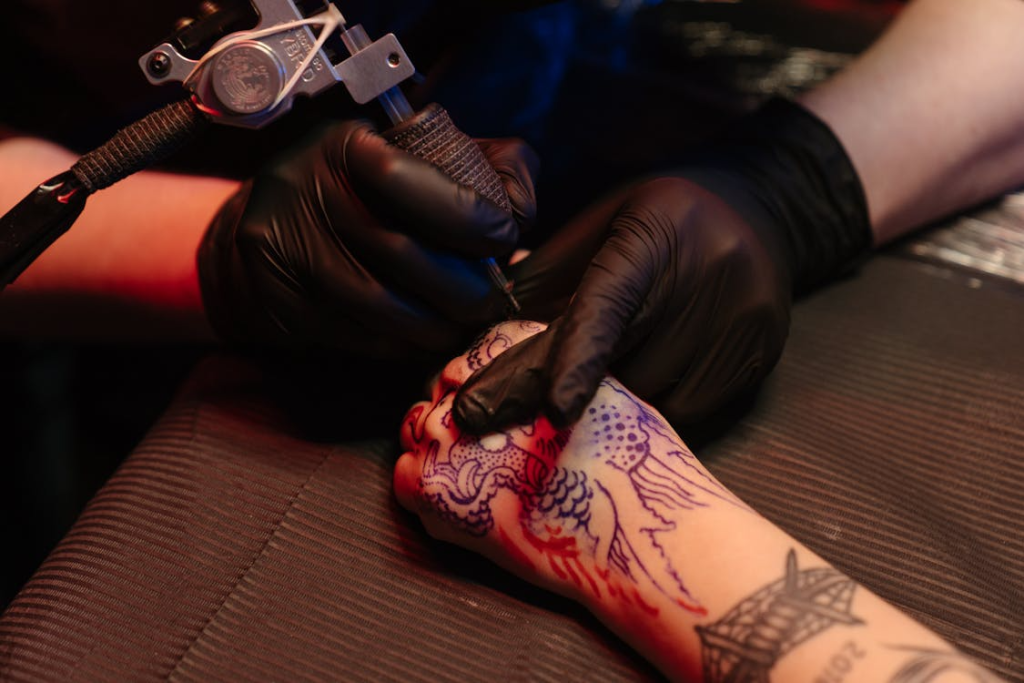Tattoos have become a popular form of self-expression, being more mainstream than ever before. Many people now adorn their bodies with ink, engraving unique and various designs. Negative stereotypes associated with tattoos have mostly dissipated. A significant portion of the adult population now has at least 1 tattoo. For instance, a 2024 survey showed 31% of Canadian adults are tattooed. Moreover, women are often more likely to get tattoos than men.
While infections and allergies are known risks when getting tattoos, the link between tattoos and cancer is a growing concern. New research is exploring this potential connection between tattoos and cancer. As popularity grows and more people get tattoos, understanding the long-term effects of tattoos and cancer risk becomes crucial.
What’s Inside Tattoo Ink?

Tattoo ink contains various chemical compounds. Many inks include pigments made from heavy metals. These can include lead, chromium, nickel, and titanium. These substances help colors remain vibrant and last longer in the skin. However, several of these metals are known carcinogens, or cancer causing. The long-term presence of these metals in the skin is a primary concern for researchers studying the link between tattoos and cancer risk.
The regulation of tattoo inks is inconsistent. In Europe, some cancer-causing chemicals are banned from use in inks. However, the United States does not approve tattoo inks before they are sold. A recent study found that nearly half of all popular tattoo inks in the U.S. contained potentially hazardous chemicals called azo-compounds. These substances can break down into cancer-causing agents when exposed to bacteria or ultraviolet light from the sun.
Read More: People Highlight 5 Early Symptoms of Cancer You Shouldn’t Ignore
How Your Body Reacts to Tattoo Ink

When you get a tattoo, your body has an immediate immune response. It recognizes the ink as a foreign substance that should not be there. The immune system is activated and begins to attack these foreign particles. While some ink remains visible in the skin’s dermal layer, a significant portion does not stay there and eventually gets attacked by your immune cells. Your immune system works to clear the foreign particles away from the injection site over time.
Much of the ink is then transported away from the skin. It travels through the lymphatic system to the lymph nodes. The lymph nodes are an important part of your immune system, filtering harmful substances from the body. The tattoo pigment builds up in these nodes, where it can remain for years. This process has sparked an investigation into the connection between tattoos and cancer, most particularly lymphoma.
Read More: She Started Her Extreme Body Mod Aged 11. Is this a Passion or Disorder?
The Connection to Lymphoma

Recent studies suggest a possible association between tattoos and lymphoma. Lymphoma is a cancer that affects the lymphatic system. A Swedish study analyzed data from nearly 12,000 people. It found that individuals with tattoos had a 21% higher risk of developing lymphoma compared to those without tattoos.
The risk appeared highest for specific types of lymphoma. The most common forms identified in the Swedish study were diffuse large B-cell lymphoma and follicular lymphoma. Another alarming finding was that the risk was greatest for people who got their first tattoo recently. Those who got tattoos less than 2 years before their diagnosis faced a significantly higher risk of lymphoma.
This suggests a potential link between the initial immune response to the tattoo and the cancer’s development. While the relative risk is higher for tattooed individuals, the absolute risk increase is small. The studies show an association, not a confirmed cause-and-effect link.
Does Tattoo Size Matter?

Some studies have found that larger tattoos are associated with a greater risk. A Danish twin study reported a hazard rate for lymphoma nearly 3 times higher for people with large tattoos compared to those without tattoos. This suggests that the total amount of ink injected into the body could play a significant role in increasing risk. More ink means more pigment builds up in the lymph nodes over time. This increased exposure could amplify the long-term strain on the immune system and elevate the potential for cancer development.
However, not all research agrees on the importance of size. The Swedish study that found a 21% increased lymphoma risk did not find that size made a difference. In that study, the risk was elevated for tattooed individuals regardless of how large their tattoos were.
Read More: The ‘My Body, My Choice’ Philosophy Includes Ear Piercing
Tattoos and Skin Cancer Risk

In addition to lymphoma, tattoos may also increase the risk of skin cancer. Tattoo ink injected into the skin can be affected by sun exposure. Ultraviolet (UV) light can cause pigments to degrade. This process may release potentially carcinogenic substances into the body. This is a particular concern for people who frequently expose their tattoos to sunlight. Using sunscreen or protective clothing is often recommended for this reason.
A Danish study of twins also examined the tattoo and cancer risk for skin. The research pointed to an increased risk of skin cancers among people with tattoos. The case-control portion of the study found that the risk of skin cancer was 1.62 times higher in tattooed individuals. The risk was even higher for specific types of skin cancer, such as basal cell carcinoma, especially with larger tattoos.
While some studies show an elevated risk, the evidence is not yet conclusive. For example, some research found no increased risk for cutaneous squamous cell carcinoma. The scientific community agrees that more robust studies are needed to fully understand the link between tattoos and skin cancer. Until then, people with tattoos should invest in sun protection and monitor their skin for any unusual changes.
Uncertainties in the Current Research

While recent findings are concerning, there are still many uncertainties. It is critical to remember that these studies show an association, not direct causation. This means that tattoos and a higher cancer risk tend to occur together. It does not definitively prove that tattoos cause cancer. Other factors could be influencing the results. For example, lifestyle habits associated with getting tattoos could also contribute to cancer risk.
Making an Informed Decision

Ultimately, definitive answers may be decades away. Until larger, long-term studies provide more clarity, caution is advisable. If you have tattoos, protecting them from the sun is important. If you are prone to allergies or have sensitive skin, it is advised to proceed with caution when getting a tattoo. In the end, the decision is personal, but it should be based on the best available scientific information regarding tattoos and cancer.
Disclaimer: This information is not intended to be a substitute for professional medical advice, diagnosis or treatment and is for information only. Always seek the advice of your physician or another qualified health provider with any questions about your medical condition and/or current medication. Do not disregard professional medical advice or delay seeking advice or treatment because of something you have read here.
Read More: Paraphenylenediamine: 7-Year-Old Girl Suffers Chemical Burns from Black Henna
